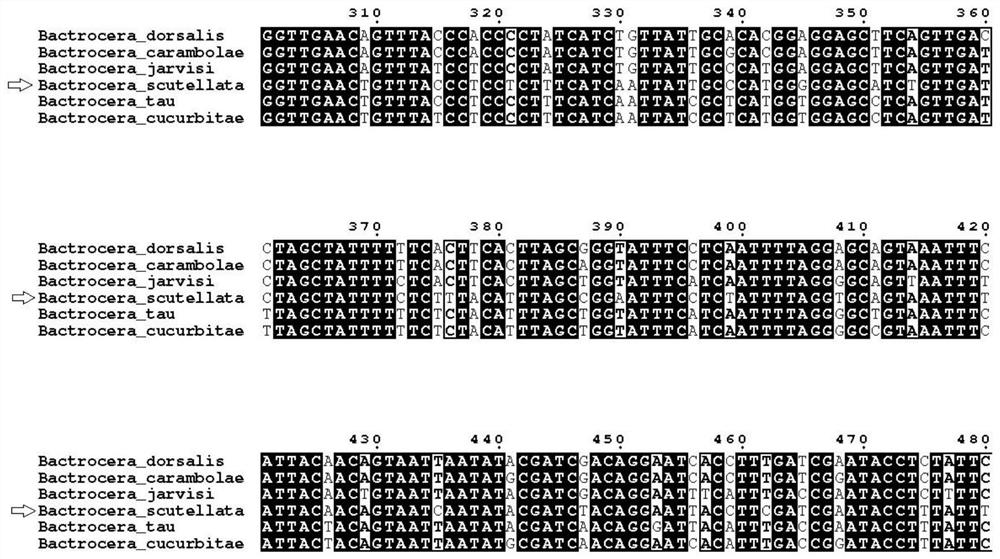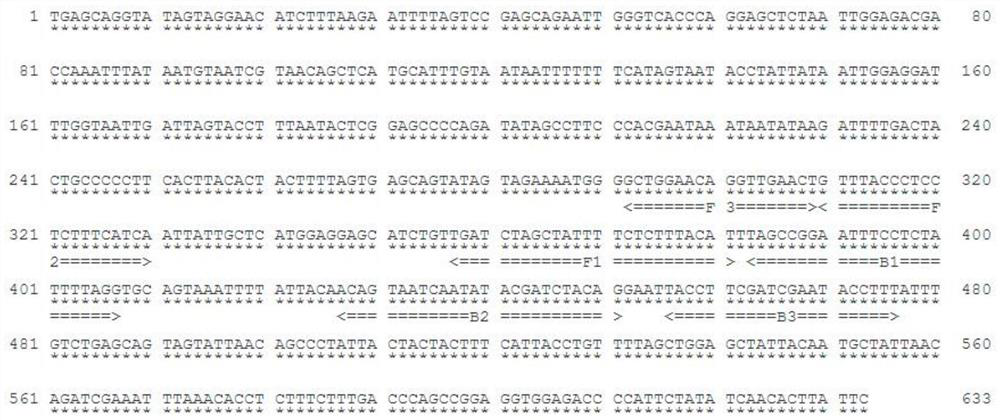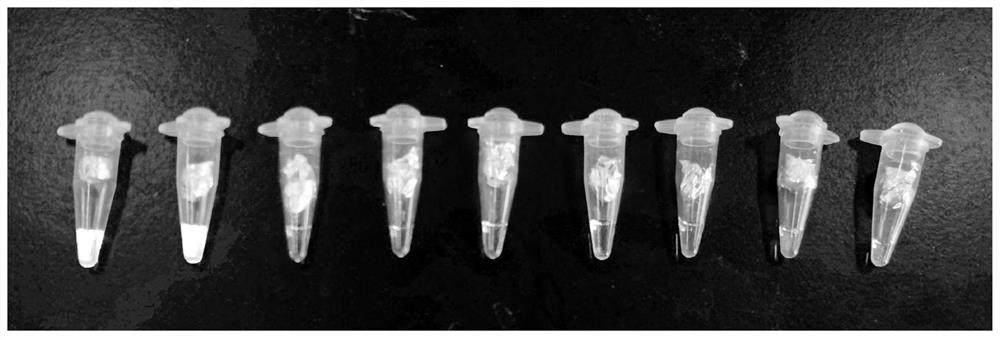Method for detecting bactrocera scutelata hendel based on visual LAMP (loop-mediated isothermal amplification) technology and application
A technology for detecting fruit flies, which is applied in the field of fruit fly detection based on visual LAMP technology, can solve the problems that fruit flies cannot be detected, and achieve the effects of avoiding aerosol pollution, high sensitivity, and simple result detection
- Summary
- Abstract
- Description
- Claims
- Application Information
AI Technical Summary
Problems solved by technology
Method used
Image
Examples
Embodiment 1
[0029] Example 1 Primer Design
[0030] Based on a 633bp fragment (SEQ ID NO: 1) on the mitochondrial COI gene of Ceratitis cerevisiae. The sequence is as follows:
[0031] SEQ ID NO: 1:
[0032]TGAGCAGGTATAGTAGGAACATCTTTAAGAATTTTAGTCCGAGCAGAATTGGGTCACCCAGGAGCTCTAATTGGAGACGACCAAATTTATAATGTAATCGTAACAGCTCATGCATTTGTAATAATTTTTTTCATAGTAATACCTATTATAATTGGAGGATTTGGTAATTGATTAGTACCTTTAATACTCGGAGCCCCAGATATAGCCTTCCCACGAATAAATAATATAAGATTTTGACTACTGCCCCCTTCACTTACACTACTTTTAGTGAGCAGTATAGTAGAAAATGGGGCTGGAACAGGTTGAACTGTTTACCCTCCTCTTTCATCAATTATTGCTCATGGAGGAGCATCTGTTGATCTAGCTATTTTCTCTTTACATTTAGCCGGAATTTCCTCTATTTTAGGTGCAGTAAATTTTATTACAACAGTAATCAATATACGATCTACAGGAATTACCTTCGATCGAATACCTTTATTTGTCTGAGCAGTAGTATTAACAGCCCTATTACTACTACTTTCATTACCTGTTTTAGCTGGAGCTATTACAATGCTATTAACAGATCGAAATTTAAACACCTCTTTCTTTGACCCAGCCGGAGGTGGAGACCCCATTCTATATCAACACTTATTC
[0033] View the sequences of Bactrocera scutellata at the same position as Bactroceradorsalis, Bactrocera carambolae, Bactrocera jarvisi, Bactroceratau and Bac...
Embodiment 2
[0043] The specific detection of embodiment 2 primers
[0044] Configure the LAMP reaction solution of Bacteria cerevisiae according to the following composition:
[0045] Reaction solution A: 10×ThermoPol buffer, MgSO 4 (100mmol / L), dNTP mixture (10mmol / L), Betaine (5mol / L), Bst DNA large fragment polymerase (8U / uL), 2 pairs of primer sequences F3 nucleic acid sequence as shown in SEQ ID No.2, The nucleic acid sequence of B3 is shown in SEQ ID No.3, the nucleic acid sequence of FIP is shown in SEQ ID No.4, and the nucleic acid sequence of BIP is shown in SEQ ID No.5.
[0046] Reaction solution B: 10000×SYBR Green I
[0047] The system composition of reaction solution A is:
[0048]
[0049] a) Preparation of Ceratitis cerevisiae DNA template
[0050] Take the whole body or part of the tissue samples of the insects to be tested, use the DNeasy Blood & Tissue kit (QIAGEN), and refer to the instructions of the kit to extract genomic DNA.
[0051] b) LAMP test results
...
Embodiment 3
[0055] Embodiment 3 Sensitivity detection
[0056] Use an ultra-micro-volume ultraviolet spectrophotometer (Nano-200) to detect the initial concentration of the B. cerevisiae DNA template, take 1 μL template and add 9 μL ddH 2 O carry out 10-fold serial dilution, and the selected dilutions are: 1ng / μL, 1×10 -1 ng / μL, 1×10 -2 ng / μL, 1×10 -3 ng / μL, 1×10 -4 ng / μL, 1×10 -5 ng / μL and 1×10 -6 ng / μL. Add DNA template ul of different concentrations above to reaction solution A, mix well, inactivate at 63°C for 40min, and 85°C for 5min. After the reaction, centrifuge with a palm centrifuge to allow the nucleic acid dye to mix into the system. The results show that the minimum detection concentration of this method can reach 1×10 -6 ng / μL. like Figure 5 As indicated, the detected DNA template concentrations were 1 ng / μL, 1×10 -1 ng / μL, 1×10 -2 ng / μL, 1×10 -3 ng / μL, 1×10 -4 ng / μL, 1×10 -5 ng / μL and 1×10 -6 ng / μL. in 1×10 -6 The fluorescence intensity can still be disti...
PUM
 Login to View More
Login to View More Abstract
Description
Claims
Application Information
 Login to View More
Login to View More - R&D
- Intellectual Property
- Life Sciences
- Materials
- Tech Scout
- Unparalleled Data Quality
- Higher Quality Content
- 60% Fewer Hallucinations
Browse by: Latest US Patents, China's latest patents, Technical Efficacy Thesaurus, Application Domain, Technology Topic, Popular Technical Reports.
© 2025 PatSnap. All rights reserved.Legal|Privacy policy|Modern Slavery Act Transparency Statement|Sitemap|About US| Contact US: help@patsnap.com



